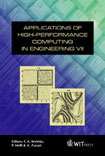Computation Of The Starting Flow In A Shock Tunnel 2D Nozzle
Price
Free (open access)
Volume
27
Pages
Published
2002
Size
842 kb
Paper DOI
10.2495/HPC020141
Copyright
WIT Press
Author(s)
J. A. Moríñigo
Abstract
This paper summarizes the results obtained with a Reynolds Averaged Navier- Stokes solver applied to the case of the starting flow in the two-dimensional nozzle section of a shock tube and which constitutes a numerical test to assess the accuracy of the code when dealing with highly non-stationary internal flows with shock waves interactions. Since the shock-boundary layer phenomenon drives the flow separation on the nozzle flaps and turbulence plays an important role on the evolution of the structures which arise, the need of an adequate turbulence closure, as well as the temporal resolution of the flow by using a small enough time-step, makes the computations expensive. Within this framework and to drop the computing time down, the parallel implementation of the solver based on the MPI paradigm has been exploited to carry out a set of simulations with various eddy viscosity models. 1 Introduction The patterns of shock waves and contact surfaces which arise in a two- dimensional round-inlet wedge nozzle after the impingement of a planar shock wave generated in a shock tunnel, has been investigated experimentally by Amann [l], [2], [3], who visualized the flowfield by means of shadowgraph and interferometry techniques. Besides the experiments, numerical simulations of the starting process have been conducted under different approaches: Saito & Takayama [4] computed the time dependent flowfield with a full Navier-Stokes solver; Saito et al. [5] compared the Navier-Stokes and Euler solutions for the same testcase. Igra et al. [6] performed Euler simulations for the sharp inlet wedge tested by Amann; Tokarcik-Polsky et al. [7], [8] and Prodromou &
Keywords




